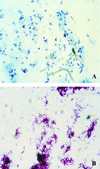Inhibitory effect of NO-releasing ciprofloxacin (NCX 976) on Mycobacterium tuberculosis survival
- PMID: 12821482
- PMCID: PMC161842
- DOI: 10.1128/AAC.47.7.2299-2302.2003
Inhibitory effect of NO-releasing ciprofloxacin (NCX 976) on Mycobacterium tuberculosis survival
Erratum in
- Antimicrob Agents Chemother. 2004 Jan;48(1):368
Abstract
Here, we report the antimycobacterial activity of NCX 976, a new molecule obtained adding a NO moiety to the fluoroquinolone ciprofloxacin, on Mycobacterium tuberculosis H37Rv strain, both in a cell-free model and in infected human macrophages. Unlike unaltered ciprofloxacin, NCX976 displayed a marked activity also at low-nanomolar concentrations.
Figures




Similar articles
-
An in vitro investigation of the bioactivities of ciprofloxacin and the new fluoroquinolone agents clinafloxacin (CI-960) and PD 131628 against Mycobacterium tuberculosis in human macrophages.Chemotherapy. 1995 Jul-Aug;41(4):234-8. doi: 10.1159/000239350. Chemotherapy. 1995. PMID: 7555202
-
Comparative antimycobacterial activities of ofloxacin, ciprofloxacin and grepafloxacin.J Antimicrob Chemother. 1999 Nov;44(5):647-52. doi: 10.1093/jac/44.5.647. J Antimicrob Chemother. 1999. PMID: 10552981
-
In vitro activity of the new difluorinated quinolone sparfloxacin (AT-4140) against Mycobacterium tuberculosis compared with activities of ofloxacin and ciprofloxacin.Antimicrob Agents Chemother. 1991 Sep;35(9):1933-6. doi: 10.1128/AAC.35.9.1933. Antimicrob Agents Chemother. 1991. PMID: 1952872 Free PMC article.
-
In-vitro activities of quinolones against mycobacteria.J Antimicrob Chemother. 1993 Dec;32(6):797-808. doi: 10.1093/jac/32.6.797. J Antimicrob Chemother. 1993. PMID: 8144420 Review.
-
Prospects for development of new antimycobacterial drugs, with special reference to a new benzoxazinorifamycin, KRM-1648.Arch Immunol Ther Exp (Warsz). 2000;48(3):183-8. Arch Immunol Ther Exp (Warsz). 2000. PMID: 10912623 Review.
Cited by
-
The role of airway epithelial cells in response to mycobacteria infection.Clin Dev Immunol. 2012;2012:791392. doi: 10.1155/2012/791392. Epub 2012 Apr 18. Clin Dev Immunol. 2012. PMID: 22570668 Free PMC article. Review.
-
Reinforcing the Functionality of Mononuclear Phagocyte System to Control Tuberculosis.Front Immunol. 2018 Feb 9;9:193. doi: 10.3389/fimmu.2018.00193. eCollection 2018. Front Immunol. 2018. PMID: 29479353 Free PMC article. Review.
-
Innate Immunity Holding the Flanks until Reinforced by Adaptive Immunity against Mycobacterium tuberculosis Infection.Front Microbiol. 2016 Mar 14;7:328. doi: 10.3389/fmicb.2016.00328. eCollection 2016. Front Microbiol. 2016. PMID: 27014247 Free PMC article. Review.
-
Nitric oxide generated from isoniazid activation by KatG: source of nitric oxide and activity against Mycobacterium tuberculosis.Antimicrob Agents Chemother. 2004 Aug;48(8):3006-9. doi: 10.1128/AAC.48.8.3006-3009.2004. Antimicrob Agents Chemother. 2004. PMID: 15273113 Free PMC article.
-
Requirements for nitric oxide generation from isoniazid activation in vitro and inhibition of mycobacterial respiration in vivo.J Bacteriol. 2004 Aug;186(16):5427-31. doi: 10.1128/JB.186.16.5427-5431.2004. J Bacteriol. 2004. PMID: 15292144 Free PMC article.
References
-
- Alangaden, G. J., and S. A. Lerner. 1997. The clinical use of fluoroquinolones for the treatment of mycobacterial diseases. Clin. Infect. Dis. 25:1213-1221. - PubMed
-
- Chan, E. D., J. Chan, and N. W. Schluger. 2001. What is the role of nitric oxide in murine and human host defense against tuberculosis? Current knowledge. Am. J. Respir. Cell Mol. Biol. 25:606-612. - PubMed
-
- Clark, I. A., and K. A. Rockett. 1996. Nitric oxide and parasitic disease. Adv. Parasitol. 37:1-56. - PubMed
-
- Colasanti, M., T. Persichini, G. Venturini, and P. Ascenzi. 1999. S-nitrosylation of viral proteins: molecular bases for antiviral effect of nitric oxide. IUBMB Life 48:25-31. - PubMed
Publication types
MeSH terms
Substances
LinkOut - more resources
Full Text Sources

